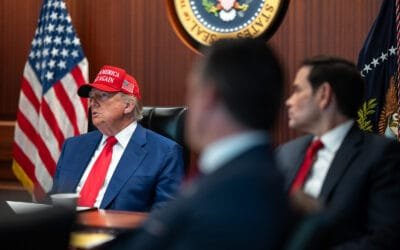I hate to say it, but it’s looking like my technician friend Fred Goodman was right when he issued a sell signal a couple of weeks ago. Yes, earnings are surging and the economy-wide recovery is accelerating, with the technology sector leading the way. But in case you haven’t seen the tickertape this week, the stock market is seeing something it doesn’t like. Something it really doesn’t like.
What can it be? For those of us who have been bullish all year, we need an answer. And I think I know what it is.
All year the market has been benefiting from smart economic policies from the White House and the Fed. But now, just as those smart policies are starting to really bear fruit, policy is turning stupid. If this keeps up, we’re going to snatch economic defeat from the jaws of victory.
Let’s start with the Fed. When I first started writing this column more than two years ago, I talked about the need for the Fed to address the problem of monetary deflation. Back then, few were talking about deflation — it was thought to be virtually impossible for anything but inflation to occur in an economy that uses paper money. Finally, about a year ago, Alan Greenspan and other Fed officials acknowledged the reality of deflation — and started doing something about it. Cheers and applause — better late than never. Deflation is now not a problem anymore.
But now that deflation’s not a problem, it’s all anyone can talk about — including the Fed. Never mind the fact that the price of gold — the most sensitive inflationary fire alarm — has soared to nearly decade-long highs, and is dragging other commodity prices with it. Never mind that the dollar is something like 30% off its deflationary peak. Never mind the fact that the producer price index is up 2.4% over last year. Never mind that long-term interest rates have surged 100 basis points off their June lows. There’s not a whiff of deflation in any of that. Not a whiff. If anything, these are warning signs of the opposite: inflation.
Yet Fed officials keep saying that they’re worried about deflation, and don’t see any signs whatsoever of inflation. So they’re going to keep interest rates ultra-low for what they call a “considerable time,” until they see the employment situation improve — no matter what other signs of economic recovery there are. Sure, if you really believe that there’s absolutely no risk of inflation whatsoever, then that’s what you’d do. In fact, why stop there? Why not print money and drop it out of helicopters? That, in essence, is what the Fed is doing by keeping interest rates so low when there’s no deflation anymore.
Now what happens when you treat a disease that the patient doesn’t really have? Easy — you make the patient sick. And that’s what the Fed is doing now. By fighting nonexistent deflation, it’s in the process of inducing inflation. After all the pain our economy suffered to eradicate inflation in the early 1980s, you’d think that this would be a mistake the Fed wouldn’t have to make again. But they’re in the process of making it. If gold breaks out above $400, we’re looking at a real problem.
Unfortunately, the White House is making the inflationary risk worse. As readers of this column know, I’ve been head-over-heels in love with President Bush’s tax cuts this year, and see them as primarily responsible for the recovery in the stock market and the economy. But now the White House is playing a dangerous and politically motivated game with trade policy — and the fate of the US dollar and everything denominated in dollars hangs in the balance.
As Bush’s popularity has sagged in the opinion polls, he’s seeing the 2004 election as increasingly likely to be a toss-up. So he needs every vote he can get, especially in the “red states” in the Midwest — his stronghold. Those are the states with heavy manufacturing industries, and their lobbyists are crawling all over Washington right now telling anyone who will listen that they’re losing jobs to competitors in Japan and China. The Bush administration wants very much to be seen as “doing something” to help.
So Treasury Secretary John Snow takes a trip to China, and tells the Chinese that they should revalue their currency, the renminbi, to make Chinese exports more expensive for American consumers (so that American industries can compete more effectively). Next, Snow takes a trip to Dubai for the meeting of G7 finance ministers, and tells the Japanese the same thing about their currency, the yen. The Chinese turned Snow down flat — but the markets seem to have assumed that the Japanese are going to play ball. Monday this week, the first market day following the G7 meeting, the yen soared (that is to say, the dollar collapsed).
Think for a moment what it means for a US Treasury Secretary to fly around the world saying that he thinks that the US dollar should be worth less. That’s the same thing as saying that all savings and investments denominated in dollars should be worth less. And that’s the same thing as telling investors to get the heck out of Dodge. Which is what stock investors have been doing this week (bond investors would be bailing out, too, except for the fact that the Fed is holding interest rates artificially low — that’s the next shoe to drop).
Oh, yes, Snow always says he believes in a “strong dollar” policy. And indeed my administration contacts assure me that he really does. They tell me that the administration is just trying to appear to be working for a weaker dollar, so that the Midwest lobbyists think they’re “doing something.” That makes lobbying our trading partners to strengthen their currencies far worse that a case of “be careful what you wish for.” It’s a case of “be careful what you pretend to wish for.” That’s worse, because you just might get it — and in the meantime the world thinks you’re somewhere between a fool and a fake (maybe both).
In the end, it’s a reality that’s been proven over and over that you can’t affect the amount of trade between two countries by playing games with their currency exchange rates. But while you’re waiting to have no long-term effect, you cause no end of short-term mischief as the values of everything denominated in both currencies have to undergo painful readjustments. And when it’s all over, there aren’t going to be any additional manufacturing jobs in the Midwest than there would have been anyway.
So the market is worried about the dollar. And the market is worried about inflation. But on a deeper and more important level, the market is worrying about whether economic policy makers have succumbed to short-term political pressures — or simply lost their minds. And everything was going so well.
This economic recovery still has lots of momentum. And it’s not too late for policy makers to pull back from these mistakes — and they very well may after they’ve seen the way the stock market is acting all of a sudden. So please don’t think I’m telling you to sell everything and go hide in a fallout shelter somewhere. I’m still bullish — but now I’m worried, too. You’ll want to make sure that fallout shelter is stocked with all the stuff you’ll need — just in case.
Originally published on SmartMoney.com.









